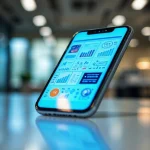Breakthrough Display Technologies Redefining Smartphone Design
The advent of foldable screens and rollable displays is revolutionizing smartphone design by enabling unprecedented device flexibility and portability. Foldable screens allow smartphones to transform from a compact phone into a larger tablet-like device, enhancing usability without compromising pocketability. Similarly, rollable displays offer smooth expansion and retraction, providing users with adaptable screen sizes according to need.
Underpinning these innovations is flexible OLED technology, which delivers vibrant colors and deep contrast while bending without damage. Recent advances focus on improving durability, addressing early concerns over repeated folding causing screen wear or creasing. Manufacturers now integrate ultra-thin protective layers and hinge mechanisms designed for millions of folds.
In the same genre : How Can Smartphones Revolutionize UK Computing Practices?
Market adoption of next-gen smartphone displays is accelerating. Early foldable models demonstrated potential but faced limitations in price and robustness. Newer devices incorporate refined flexible OLED panels for seamless viewing and user-friendly folding. Consumer interest is high, driving brands to explore rollable displays as the next frontier in screen innovation, promising smartphones that effortlessly adapt to tasks and environments.
Such breakthroughs herald a future where smartphone form factors are no longer constrained by rigid screens but instead evolve dynamically with user lifestyles.
In parallel : How is artificial intelligence influencing UK smartphone features?
AI and Machine Learning Transforming Mobile Capabilities
Artificial intelligence has become a cornerstone in enhancing smartphone AI performance, driving personalized and predictive features that adapt to user habits. By leveraging on-device machine learning, smartphones analyze data locally, ensuring faster responses and increased privacy without relying heavily on cloud servers. This shift boosts security by limiting sensitive data exposure, making AI-powered features more reliable and trustworthy.
Moreover, AI-powered features are revolutionizing everyday interactions. For example, virtual assistants now understand context better, offering tailored suggestions and automating routine tasks effectively. In photography, smart camera enhancements utilize AI to optimize settings, detect scenes, and improve image quality in real-time, creating sharper photos even in low-light conditions. This real-time analysis depends heavily on advanced AI algorithms running directly on devices, showcasing the synergy between AI and mobile hardware.
User assistance functions also benefit from these advancements, with AI helping to predict user needs, streamline notifications, and manage device performance intuitively. As mobile AI continues to evolve, it promises an even more seamless and secure experience through its blend of personalization, on-device processing, and intelligent automation.
Augmented and Virtual Reality Integration for Enhanced User Experiences
The evolution of AR smartphones has significantly advanced hardware capabilities, enabling smoother and more immersive VR integration. Modern devices now feature enhanced processors, improved cameras, and dedicated sensors, all contributing to faster and more accurate mixed reality interactions. These hardware improvements pave the way for seamless experiences that blur the lines between physical and digital worlds.
Mobile AR applications increasingly leverage these advancements, with developers creating software that adapts dynamically to various environments. The rise of mixed reality apps enhances user engagement by combining elements of both augmented and virtual reality, providing interactive and context-aware experiences on the go. These services are no longer confined to entertainment; they are branching out into practical applications.
Industry use cases continue to expand rapidly, with sectors such as healthcare, education, and retail discovering valuable applications for AR and VR. For example, mobile AR applications assist in medical training, while retail leverages mixed reality for virtual try-ons. Anticipated widespread consumer adoption is fueled by the clear benefits of immersive interaction, portability, and personalization featured in these cutting-edge technologies.
Battery Innovations and Sustainable Power Solutions
Battery technology is evolving rapidly to address the twin challenges of smartphone battery life and environmental impact. One shining breakthrough is the development of solid-state batteries, which replace the liquid electrolyte with a solid material. This innovation not only boosts energy density but also improves safety by reducing flammability risks. Similarly, graphene batteries offer faster charging speeds and longer lasting cycles, pushing the boundaries of what’s possible for everyday devices.
Fast charging technologies are also making headway, with standards like USB Power Delivery and Quick Charge enabling users to replenish their smartphone batteries in minutes rather than hours. Wireless charging has advanced, too, providing more convenience without the need for cables, and some new models even support reverse wireless charging to power accessories on the go.
Sustainability is becoming a priority in the battery industry. Manufacturers increasingly use environmentally friendly tech by sourcing materials responsibly and integrating recycled components. These efforts reduce the ecological footprint associated with battery production and disposal, aligning with global goals to minimize electronic waste and conserve natural resources.
By focusing on battery life, charging speed, and eco-conscious innovation, these developments offer compelling solutions for smarter, greener technology.
Privacy, Security, and Connectivity in Next-Gen Smartphones
Next-generation smartphones are setting new standards in mobile security by integrating advanced biometric authentication methods like under-display fingerprint scanners and facial recognition with anti-spoofing measures. These enhancements safeguard user data by verifying identity quickly and accurately while reducing reliance on passwords.
Data privacy is further reinforced through on-device processing, which limits sensitive information from being transmitted externally. This minimizes the risk of breaches by keeping biometric and personal data locally encrypted and isolated. Such approaches address growing concerns about personal privacy amid the increased intelligence and data gathering capabilities of modern devices.
Connectivity is also evolving rapidly, with 5G networks becoming the foundation for seamless communication and the Internet of Things. However, early research into 6G connectivity promises even faster speeds, lower latency, and more robust security protocols, potentially transforming how smartphones interact globally.
This transition raises questions about balancing enhanced connectivity with privacy concerns. As devices become more interconnected, ensuring secure data transmission and user control over shared information remains critical. Manufacturers and service providers must continue innovating in mobile security to protect users while embracing the benefits of emerging 5G and 6G networks.
Expert Insights and Predictions for the Smartphone Industry
Exploring what lies ahead in mobile technology.
Industry forecasts consistently highlight rapid advancements in mobile technology trends, with experts predicting accelerated adoption of 5G, AI integration, and foldable displays over the next five years. Leading analysts foresee a shift towards more immersive user experiences enabled by augmented reality and enhanced camera systems.
Manufacturers emphasize that market predictions favor sustainability and energy efficiency, as consumer demand grows for eco-friendly devices. According to expert commentary, this focus is likely to influence smartphone design and production processes profoundly in the coming decade.
Timelines for anticipated technology adoption vary, but industry insiders generally agree that 5G connectivity will become standard by 2025, followed by widespread use of AI-driven features within three years. Furthermore, the integration of biometric security enhancements is expected to become more sophisticated, making smartphones not only smarter but also more secure.
Overall, the expert insights suggest a future where smartphones evolve beyond communication tools to become central hubs for augmented reality, health monitoring, and personalized AI assistance. This trajectory will undoubtedly transform how users interact with technology in day-to-day life.








